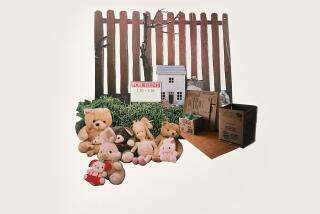Immigrant’s Letters Offer a Window to the Past
- Share via
The letters tell a trans-Atlantic love story of a Czech woman facing a new life in the United States and her family in the Old World.
The package turned up at a house sale -- 110 letters written from the Czech region between 1909 and 1947 to Anna Kohout, a Czech immigrant and spinster who devoted her life in Cleveland to working as a housekeeper, practicing her Roman Catholic faith and sending money back to her family.
A friend bought the package for Karen Donovan Godt, an artist who uses old letters and documents to design postcards and collages.
Godt planned to use Kohout’s letters in her artwork.
The effort turned into a labor of love for Godt, who became fascinated by the story the letters told.
“I had to find out about her,” Godt said. “Part of it was spiritual. Her story -- I felt I needed to know her.”
Godt enlisted the help of Winston C. Christlock, a professor of central European history at the University of St. Thomas in St. Paul, Minn., to translate the letters.
Through surviving friends, immigration records and tidbits mentioned in the letters, Godt pieced together a portrait of Kohout as a thrifty, prayerful, single-minded woman who once turned aside an engagement offer from a man in Omaha in favor of cleaning house for a wealthy Cleveland family.
Godt, who thinks of Kohout as a kindred spirit, hopes to produce a coffee-table book about the letters and the life of a simple immigrant who was forever separated from a beloved family.
“We’re all part of the same community of life,” Godt said.
The letters tell the story of a single family but also the history of a troubled continent.
Joseph Kocab, 70, of Cleveland, who is host of a weekend Czech language radio show, said such letters can be important in documenting the history of a nation.
“It’s not scholarly writing. It’s not political writing,” he said.
“It’s their own little history, which is the history of 99% of us,” he added.
Kohout was born July 8, 1888, and grew up in the farming village of Hory Matky Bozi, south of Pilsen and too small for some contemporary maps of the Czech Republic.
She left her extended family and went to the United States at age 16, worked for a harsh boss in New York City and returned to her homeland.
After one year home, she changed her mind and returned to the United States in 1905. She settled in Cleveland, a city then expanding fast with immigrants attracted to jobs in steel mills and factories.
“She’s always sending them money,” said Christlock, who sometimes struggled for five hours on a four-page letter with florid handwriting, outdated syntax and phonetic spellings by the writers, Kohout’s four sisters and four brothers.
The hardships come through in the letters, as the Czech region struggles through World War I, disease, depression, Nazi dismemberment of their homeland and then war again.
“And now we have, thanks to God, a free republic, and we expect it to be better,” the family wrote in 1919 after the end of World War I.
Czech freedom lasted two decades until Nazi Germany expanded, eventually leading to World War II.
“We brought the sacrifice to the altar of peace, and now we await what others will give on that altar,” brother Jindrich wrote Jan. 1, 1939, after Czechoslovakia handed a piece of itself to Germany in a failed attempt to create a lasting peace.
Peace did not survive the year.
In America, Kohout was working, going to church and the opera, and loyally sending money to her family as it struggled.
Their return letters often included thanks “many times for the quick and willing help” and provided a glimpse of life: family events, the crop prospects, the weather, village gossip.
They appealed to Kohout after World War I to try to travel home to visit while their mother was still alive.
“Certainly we could give her great joy from those sorrows which the old years brought to her more than to others,” brother Josef wrote.
There are complaints about political infighting, which emerged as Czechoslovakia became a free nation, sorrow for those killed in combat and praise for “the glorious man President Wilson,” who championed Czech independence.
“It’s unusual to get the documentation of everyday life from everyman’s perspective,” said Carmen Langel, curator of the National Czech & Slovak Museum & Library in Cedar Rapids, Iowa. Hearing a description of the letter collection, she said her museum has nothing like it. Most artifact collections focus on significant events in history, especially from a leadership point of view, she said.
Homespun letters tell you “not just what’s going on in society but what’s important to them. Obviously, weddings are important, or the weather, or whatever,” Langel said.
Mila Hyvnar, a 75-year-old Czech immigrant and former Czech language newspaper editor in Cleveland, said she missed having such letters from her family after she fled her then-Communist-dominated homeland in 1948.
The Communist regime barred letters to relatives who had emigrated illegally, according to Hyvnar, who sent relatives letters that were smuggled by travelers.
The letters to Kohout stopped in 1947, as the Communists consolidated their control over Czechoslovakia after World War II.
“Life was very difficult for them,” Hyvnar said.
With the end of the letters, there’s no clue about how much later contact Kohout had with her family, although it likely declined as her siblings died, Godt said.
Kohout lived to age 97.
More to Read
Sign up for Essential California
The most important California stories and recommendations in your inbox every morning.
You may occasionally receive promotional content from the Los Angeles Times.












